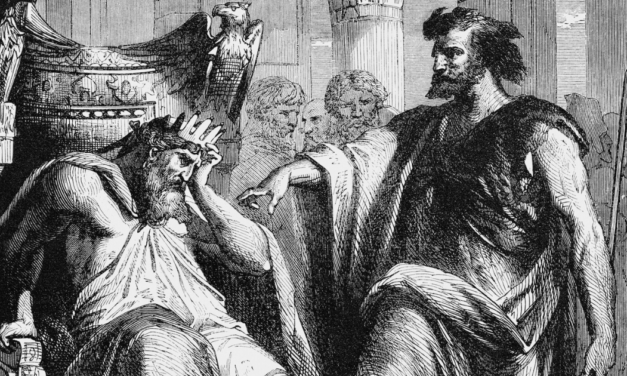This article first appeared in Christian Research Journal Fall (1989). The full text of this article in PDF format can be obtained by clicking here. For further information or to subscribe to the Christian Research Journal go to: http://www.equip.org/christian-research-journal/
Perhaps the most significant question posed to believers in our “post-Christian” culture revolves around the inspiration of Scripture. Is the Bible in fact divinely inspired or merely human in origin?
Oftentimes when quoting Scripture in witnessing situations, I’ve been challenged with the words: “Who says the Bible is true or accurate in the first place?” Although this objection often strikes terror in the heart of the average Christian, it is not really as difficult to deal with as one might think. I have found fulfilled prophecy to be an extremely effective resource in responding to this challenge. The prophetic evidences for the Bible’s trustworthiness are so overwhelming that anyone with a truly open mind will be compelled to consider the Bible’s central message: redemption in Jesus Christ.
Begin by pointing out that the Bible contains almost 500 specific prophecies concerning the birth, life, death, and resurrection of Jesus Christ — some of which were made well over two thousand years prior to His birth.
For example, it was not only prophesied that Christ would be a descendant of Abraham, (Gen.12:1-3), but that He would be from the tribe of Judah (Gen. 49:10) and the house of David (Ps. 110:1); that He would be born in Bethlehem (Mic. 5:2), born of a virgin (Isa. 7:1 4), betrayed for thirty pieces of silver (Zech. 11:12f.), and also that His hands and feet would be pierced (Ps. 22:16). It is noteworthy that this last prediction was made long before crucifixion was invented as a form of capital punishment by the Persians and a thousand years before it was made common by the Romans.
It was also prophesied that Christ would be crucified with transgressors (Isa. 53:9, 12); that none of His bones would be broken (Ex. 12:46; Ps. 34:20); and that He would cry out from the cross, “My God, My God, why hast Thou forsaken me?” (Ps. 22:1). Moreover, Christ’s resurrection (Ps. 16:8-11), His ascension (Ps. 68:1 8), and hundreds of other details were predicted in minute detail. These prophecies do not deal with vague generalities (as is so often the case with modern-day “prophets” and psychics); they are specific and verifiable. Each was literally fulfilled down to the smallest detail in the person of Jesus Christ.
In addition to Messianic prophecies, the Bible contains nearly 2,000 prophecies concerning almost every nation within a thousand miles of Jerusalem. I strongly suggest researching and internalizing some of these prophecies for use in witnessing situations. As an illustration let me detail the prophecy about the city of Tyre in Ezekiel 26 and its fulfillment.
Tyre was no small, obscure village. It was a great Phoenician city and a world capital for over 2,000 years. It was to the sea what mighty Babylon was to the land. Yet, in the heyday of its power, the prophet Ezekiel had the audacity to predict for it a violent future and ultimate destruction. This downfall would be due to Tyre’s flagrant wickedness and arrogance, traits that were personified in its ruler, Ittobal II, who claimed to be God.
Ezekiel predicted that many nations would come up against Tyre (Ezek. 26:3); that Babylon under Nebuchadnezzar would be the first to attack it (v. 7); that Tyre’s walls and towers would be broken down (vv. 4,9); that the stones, timbers, and debris of that great city would be thrown into the sea (v. 12); that its location would become a bare rock and a place for the drying of fishermens’ nets (vv. 4-5,14); and finally, that the city of Tyre would never be rebuilt (v.14).
History bears eloquent testimony to the fact that all this is precisely what happened. Many nations did come up against Tyre — the Babylonians, the Greeks, the Romans, the Muslims, and the Crusaders, to name a few. And Nebuchadnezzar was indeed the first of these invaders, who — after a thirteen year siege — broke down the walls and towers of mainland Tyre, thus fulfilling the first of Ezekiel’s prophecies. Nebuchadnezzar massacred all of Tyre’s inhabitants except for those who escaped to an island fortress a half mile out in the Mediterranean Sea.
Centuries after Ezekiel’s body had decomposed in his grave, Alexander the Great fulfilled a major portion of the prophecy. In order to conquer the island fortress of Tyre (without the luxury of a navy), he and his celebrated architect Diades devised one of the most brilliant engineering feats of ancient warfare. They built a causeway from Tyre’s mainland to the island fortress, using the millions of cubic feet of rubble left over on mainland Tyre. Thus Tyre was scraped bare as a rock, just as Ezekiel predicted.
The most astonishing of Ezekiel’s predictions was that Tyre would never be rebuilt. This is singularly incredible because Tyre is strategically located on the east coast of the Mediterranean Sea. It also contains the Springs of Reselain, which pump ten million gallons of fresh water daily — enough to take care of the needs of a modern city. Yet, history records that after a succession of invasions, Tyre finally and irrevocably fell in A.D. 1291 — never to be rebuilt again. Today Tyre has been humbled to the point of becoming a place for the drying of fishermens’ nets — just as Ezekiel prophesied two-and-one-half millennia ago.
This prophecy of Tyre is but one among many examples of meticulously detailed and fulfilled prophecies, any one of which is sufficient to demonstrate the truth and accuracy of Scripture. “I have spoken,” says the Lord of Hosts. The Scripture cannot be broken (John 10:35).
If it can be shown that the Bible really is the Word of God, then a host of other objections can be answered by simply referring to Scripture itself. Having demonstrated the trustworthiness of God’s Word, you can then proceed to share its central message: redemption in Jesus Christ. Remember, our goal is not to demonstrate that we are intellectually superior, but rather to use our answers as springboards or opportunities for communicating the gospel.








